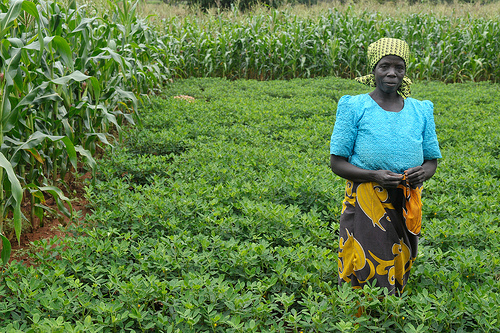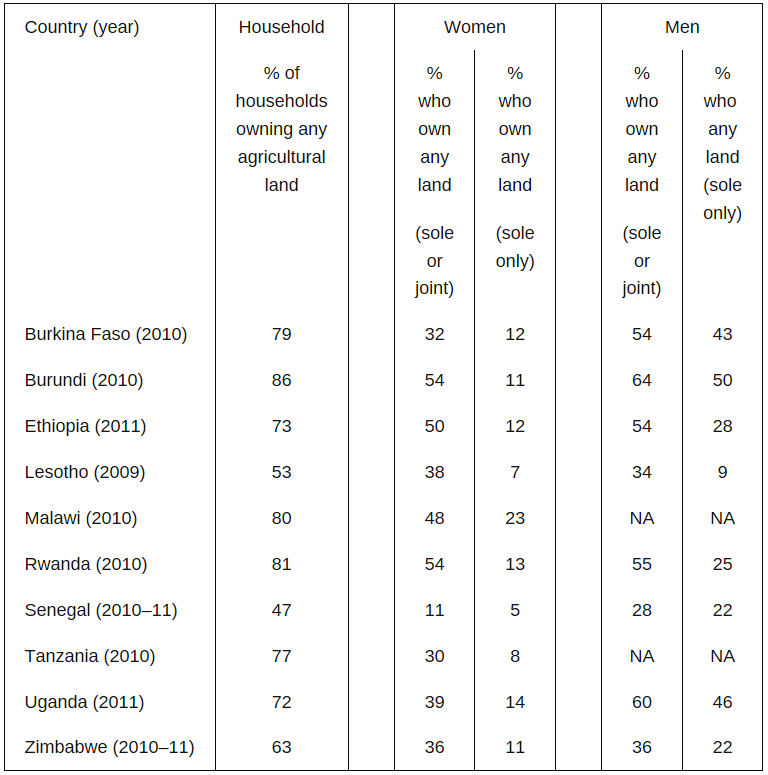Cheryl Doss argues that (as with ‘70% of the world’s poor are women‘) we need to stop using the unfounded ‘women own 2% of theworld’s farmland’ stat, and start using some of the real numbers that are emerging (while also demanding much better gender data).

Cheryl Doss is a Senior Lecturer in African Studies and Economics at Yale University and PIM's Gender Lead. She is also a member of the PIM Management Committee and leader of the PIM research Cluster on Sex-Disaggregated Data.
Cheryl is a Public Voices Fellow at The Op-Ed Project.
For advocates, nothing is better than having a powerful statistic at your disposal to use in support of a cause. In the world of women’s property rights advocacy, there’s one statistic cited by advocates more than the rest: Women own less than 2 percent of the world’s land. It certainly is a great rallying cry to mobilize people in support of equal land rights.
If only the statistic were true.
Don’t get me wrong – worldwide, women do not own anywhere near the amount of property that men do. But this statistic and its variations, often repeated by women’s rights advocacy groups including Oxfam and Action Aid, is actually unsubstantiated and advocates are doing a disservice to their own cause by using it.
Women’s land rights are critically important. We know that they are correlated with increased empowerment and better outcomes for women and children. When women have a secure claim to land, they are less vulnerable when their husband dies or leaves.
Yet, using unsubstantiated statistics for advocacy is counterproductive. Advocates lose credibility by making claims that are inaccurate and slow down progress towards achieving their goals because without credible data, they also can’t measure changes. As some countries work towards improving women’s property rights, advocates need to be using numbers that reflect these changes – and hold governments accountable where things are static or getting worse. For example, the Demographic and Health Surveys, the leading source of nationally representative data on health and population, now ask women and men (of reproductive age) in ten African countries whether or not they own land. Their data shows a far more complicated and diverse landscape than is reflected by the statistic above.
The percentage of women reporting that they own land ranges from 11% in Senegal to 54% in Rwanda and Burundi. But these numbers must be compared with those for men: The comparable figures for men are 28% in Senegal and 55% in Rwanda and 64% in Burundi. The largest gender gap in land ownership is in Uganda, where the share of men who own land is 21 percentage points higher than that for women. The gender gaps are much larger if we consider only land that is owned solely (individually), by a man or woman, rather than include both sole and joint land ownership. By having a more accurate picture of where women have more or less property rights, advocates can more effectively leverage their resources to achieve their goals.
The good news is that data is slowly becoming available. In a recent paper that I coauthored, we use data from several new sources to examine the issue of women’s land ownership. In addition, to the DHS data that we compiled above and that from the UN Food and Agriculture Organization’s women’s land rights database, we use the recent Living Standards Measurement Studies Integrated Surveys on Agriculture (LSMS-ISA). While the DHS data tells us the percentage of women and men who own land, the LSMS-ISA surveys provide plot level data on ownership and management for six countries in Africa. These surveys allow us to analyze what share of land is owned by women. These are two very different perspectives on women’s land ownership, but they tell similar stories.
The plot level data allows us to consider whether land is owned by men, women, or jointly by men and women. In all six countries, women own less land than men, but the patterns differ across countries and vary depending on the definition of ownership that is used.
These new data sources point to key issues that need to be addressed, including the importance of defining whether we are interested in statistics on women (i.e. what percentage of women own land) or on land (i.e. what percentage of land is owned by women). They also point to the importance of considering both sole and joint ownership.
As next steps, we can do two things. First, we can stop using statistics that are unsubstantiated, even if they convey an important truth. Women do own less land than men – and we can provide more details for some countries. But we don’t have a global figure.
So, what can we say? The best approach is to make a general claim and then provide numbers on a specific country or region for which data is available. Here’s some possibilities:
- Globally, more men than women own land. On average, across 10 countries in Africa, 39% of women and 48% of men report owning land, including both individual and joint ownership. Only 12% of women report owning land individually, while 31% of men do so. (note that these data only include men and women of reproductive age.)
- More of the privately owned land is reported as being owned by men than by women. In Niger, only 9% of the land is reported as owned by women, 29% jointly by men and women and 62% by men. In Tanzania, only 16% of the land is reported as owned by women, 39% jointly by men and women and 48% by men. In Ethiopia, 15% of the documented land ownership is reported as owned by women, 39% by men and women jointly, and 45% by men.
Second, we can advocate for better data. In surveys that ask, “Does anyone in the household own any land?” a follow up question that asks “Who owns the land?” would allow us to exponentially increase our understanding of the gendered patterns of land ownership. Yes, we need to consider the local context and what is meant by ownership; but this simple first step will go a long way toward providing an accurate statistic advocates can use to strengthen women’s land rights.
Related links:
Photo credit: T. Samson/CIMMYT





